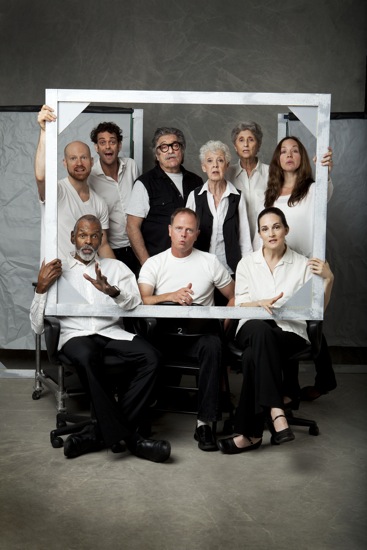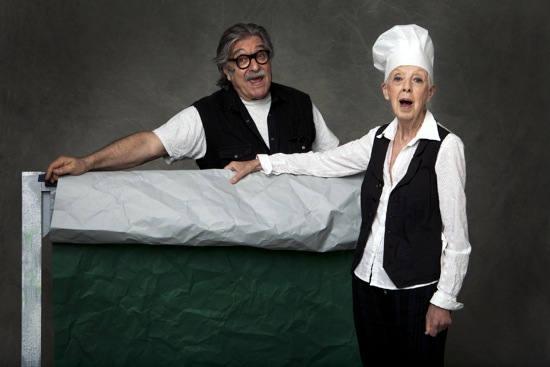Ever since the 1970s, David Gordon has been educating us into seeing that there are always two sides to everything (perhaps simultaneously), that repetition can reveal change, that words are devious game-players, and that you could be your own grandma. In his dance-theater works, where process and product often dance in lockstep, a performer may comment on what she/he—or another performer—is doing.
To construct his fascinating, brain-tossing new venture, Beginning of the End of the. . . (at the Joyce Soho through June 30), Gordon has turned his creative mind back in time to an artist as intrigued as he is by enigmas about life and performance: the writer Luigi Pirandello (1867-1936). The text for the work is based on Pirandello’s short story “A Character’s Tragedy” (1913); the play that developed out of it, Six Characters in Search of an Author; and another tale, “The Man With The Flower in His Mouth.” Not only has Gordon intermingled their characters and plots; he has taken on the role of author-director (which he is), and added the brilliant Valda Setterfield as the author’s wife and leading lady (which she is).
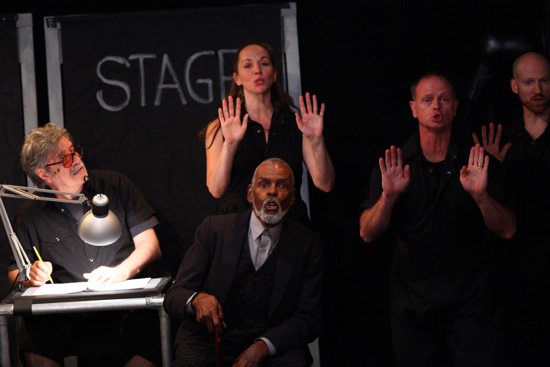
The author taken aback. Seated: David Gordon and Gus Solomons jr. Standing: Karen Graham, Scott Cunningham, Aaron Mattocks. Photo: Paula Court
In the assemblage of wonderfully nimble-witted movers and talkers (all wearing divers, mostly black outfits), Scott Cunningham, Karen Graham, and Aaron Mattocks play themselves as dancers and, when needed, a kind of Greek chorus prone to repeating others’ words in truncated form, as if for our education. David Skeist plays the Son who figures in Pirandello’s Six Characters and the Man with the Flower in his Mouth (a poetic allusion to an epithelioma, a type of cancerous growth). Gus Solomons jr acts the role of the Father in Six Characters and the Commuter who engages the doomed Man in an agitated conversation about his own missed train and the bundles he was taking home to his wife. Charlotte Cohn is both a Stepdaughter (of Solomons as Father) and the nurse who summons patient after patient to the waiting room of the doctor that the Man w/Flower has trouble getting in to see.
Norma Fire is more enigmatic as the tart Woman w/Veil (mourning a death) and Woman w/jacket (a handsome one that she wears); she’s not sure where she belongs and wonders whether she should be the Leading Lady, while telling Setterfield of her troubles with “her” husband. To add to the elusive, ultimately moving collage, these sterling performers not only play their characters, they argue with the author and comment on the production that is bringing them to life. When Setterfield complains about the words Gordon has given her to speak, she also reminds us that the complaint was written by him.
Allusions to Pirandello’s odd, unhappy marriage sneak in too, as well as “Dr. Fileno,” of “A Character’s Tragedy”— the unhappy would-be protagonist who begs the writer to create a play for him to appear in. He has decided on a survival strategy (one that is also key to Gordon’s production): regard the present as if through the large end of a telescope, so that today’s tragedy will seem to have happened long ago.
As in numerous Gordon works, the action is framed in various ways, including by actual frames. There’s an empty doorframe for some entrances. Four other wooden rectangles are hung with several window shades (sort of) that initially have “stage” written on them, but which can be flipped over to reveal “garden” These frames, several chairs, and the large lamps that figure in Jennifer Tipton’s splendid lighting can be moved around by the cast to stand for a doctor’s waiting room and other locales. White tape marks off four rectangles on the floor; sometimes these seem insignificant as separate areas, at other times, action is clearly confined to one or another. The passages of dancing bridge the space, as they do the scenes, but also create a kind of moderate turbulence that’s matched at times by Giacomo Puccini’s dramatic string quartet Crisantemi. For those people familiar with the Joyce Soho, I should point out that the audience sits on the long uptown side of the space, which provides a wider, shallower area for the performers than that created by the usual west-facing seating arrangement. This has the effect of placing us very close to the performers, and the fact that they often direct remarks to us increases the feeling of intimacy.
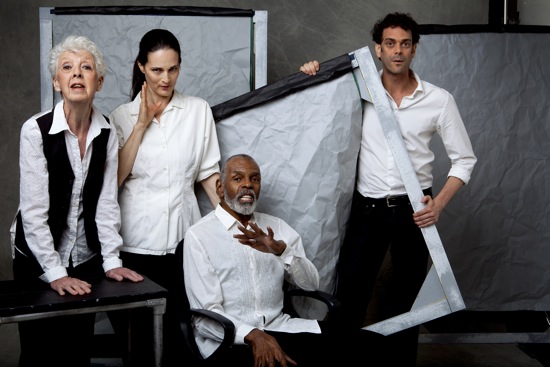
L. to R. Valda Setterfield, Charlotte Cohn, Gus Solomons Jr, and David Skeist (not in costume). Photo: Andre Eccles
The piece offers multiple viewpoints about time and distance. Setterfield, who is seated at a table applying her makeup when we enter, dons a long, intricately fastened black coat with leopard-print sleeves (surely designed years ago to wear to the opera) and begins a thoughtful, understated dance, repeating several times the same sequence of small, light, travelling steps; lunges; and fluid gestures that coast on the lilt of Puccini’s Three Minuets in A Major for String Quartet. Gradually, the other performers enter and watch her. Somewhat later, they perform what seems to be an expanded version of her solo, while, in back of them, she “marks” her dance, as if trying to recall it. You get the eerie sense that she’s not only distant from their reality in space, but also in time.
Throughout the hour-long performance, Gordon sits at the back of the space at a table atop a low platform; he has the script open in front of him, and when Setterfield goes up to him and gives him a good-luck pat and a few words, it’s clear that this is Valda-as-herself with her real-life husband. But when she steps to one of two microphones and begins to talk about Pirandello and illusion versus reality, she becomes the wife as a performer who keeps forgetting her lines and has to be prompted by her husband playing the character that he is: the writer-director. All of this, of course, is scripted. When Setterfield repeats her speech nearly an hour later, while Beginning of the End of the. . . is winding backward toward its own ending, she reads them quite differently.
The characters’ lives spill out of the plot they’re meant to be part of. In the end, Skeist angrily demands to have his character written out of the play. The roles that Pirandello wrote also intertwine with the concerns and memories of Gordon and Setterfield. She talks of herself as a young dancer in an Italian revue; somehow she then becomes a Pirandellian character (perhaps Madame Pace from Six Characters), proud, as an actress, that she can deliver the lines off the paper she holds in an Italian accent (fakey though it is). I can’t remember for sure how all the bits of Beginning of the End of the. . . mesh (count among these Setterfield donning a chef’s hat, in obedience to stage directions that Gordon reads, and she and Gordon speculating about what each might do if the other were to die first). But mesh they do. Like all Gordon’s works, this one marches along, wheeling intricately but clearly through space—every word, gesture, and dance step part of a crisp, rhythm that flows along trailing repetitions and interpolations.
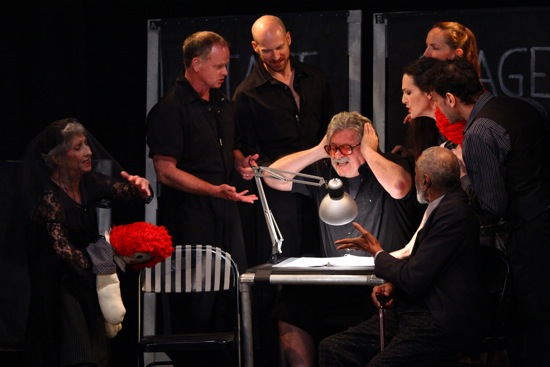
Author besieged. L. to R. Norma Fire, Scott Cunningham, Aaron Mattocks, Karen Graham, Charlotte Cohn, David Skeist, Gus Solomons jr. Photo Paula Court
The structure of the piece involves some risks. As in Six Characters in Search of an Author, two children die; the little girl drowns in a pool of water, her brother shoots himself. In this case, they’re represented by oversized Raggedy Ann and Raggedy Andy dolls, and the timing—the sudden smack when a flat tips and hits the floor, the droop of a stuffed toy’s head into a yellow mop bucket—are startlingly dramatic. Someone says “curtain.” You think the end is imminent. But this isn’t the real finish to the evening, only to the plot that Pirandello’s characters are trying to get him to write. Fragments of what we’ve seen and heard earlier are remembered, repeated, altered. Elements of the dances reappear in three-part counterpoint. The performers slip away one by one. Gordon finally stands up and shambles into the wings, leaving Setterfield alone with her solo. Bringing the past into the present. Making the present into the past.

